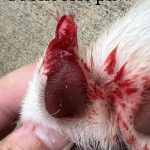If you cannot afford proper care, please consider surrendering her for adequate care. She needs to be seen by a vet immediately…ESPECIALLY if she’s pregnant!
I have a 12 month old male rescue kitten that in the past three weeks has blocked twice. We’ve spent thousands to unblock him. The emergency vet hospitals in my area have all quoted me a price of over 8,000 dollars for PU surgery. He is currently not blocked but is having trouble and discomfort while urinating and his volume isn’t great. He’s on a prescription diet and we’ve done everything we can to keep him healthy. But we feel that PU surgery is inevitable and is our only option to save his life. The emergency vet told us that if we couldn’t afford surgery they would euthanize him for us. He’s the sweetest boy and deserves a chance at a long life. We are desperate for help. We would be willing to travel in order to get him what he needs if that’s what it would take. Please help us! We love our little Loki
Comments
Hey, my 11 month, 5 week pregnant cat, suffered a very high fall yesterday, after she managed to escape from the house, and she returned with inability to walk properly on both her back legs, and i suspect it is a pelvic fracture, I’m a broke college student and Cannot afford a surgery, what limited research i did online made to think that euthanasia is the only solution, but I’ve been constantly monitoring her, she is comfortable, resting in her favourite place, she is purring, i fed her with a syringe and gave water to her the same way, i kept her litter box near here, and she did get up and pooped in it, what can I do, please help me save my baby????
Comments
Looking for personal advice as my husband got bit by a close friend’s parent’s dog yesterday unprovoked and it was a pretty aggressive bite. Her parent then told us he bit someone a month ago. I’m a nurse and am comfortable managing the wound, but as an animal lover and friend, I feel so guilty reporting it as I know what the outcome will be.
Comments
Hi, where are you located? My cat has something wrong with her esophagus, I was told by the vet after I did (X-rays, blood work, urine exam and it was like $1000.00) that I have to go to a specialist and they said they need to put a camera to see what it is and that alone cost $2200.(they said that would be just to look at what is going on and does not include treatment.) I cannot afford it because I live alone. I have two cats and I’m just doing my best, (I just moved as a single young woman by myself with my 2 cats to a new state and just trying my best) if I had the money I would’ve definitely done it right now.
The vet gave me some thing to coat her esophagus(SUCRALFATE) to try to help but I don’t see a difference(she licks her food and coughs & it discourages her from eating but I know she wants to eat) and I don’t know what else to do. I feel so very helpless, I was wondering where you are located, maybe I can get her help,she really needs help right now. Her name is Penelope and I love her.
My email is sheenar2265@gmail.com
Comments
Help please I’m stressing out . Is this going to happen again? He has been peeing
Playing, eating but I noticed he’s only peeing 1 or twice
A day is that enough? He is drinking water I need to know how to palpatate his stomach ???? I’m not able to afford much more I cannot find a affordable vet in vero beach I’m running out of options ???? I’m going to take him back if I can’t get a solution before he blocks again. I have never dealt with this. I have had female cats .
Comments
Good morning my 15 year old domestic short hair cat (Oreo) has been very lethargic, not eating or drinking for the past 3 days . I have taken him to the clinic and to the ER within these 3 days. Either place was able to give me some real insight as to what may be the problem. He does have mild azotemia. His creatine number is about 2.7! His red blood cells ate also a little in the low side. Both the clinic and ER have taken blood work. And then told me to just take him home and monitor him, but he is not showing any improvement. I’ve attached a video of him walking and his blood work for reference! What do you think could be causing this. What should be my next steps? I’ve had my cat since I was 15 I am now 30. I’m not ready for him to go. Please Help!
Comments
We have a 3 year old Husky that has 2 claws located on different paws that keep bleeding at the tip of the claw multiple times per week when she is outside in our backyard. The cause of the bleeding is not from trimming her nails too short and she is not one to be racing around the yard, potentially injuring her claws. We finally were able to get a good look at the tip of her claw to see where the source of the blood was coming from. Please see photos. It looks like the 2 claws that are bleeding may have broken so far down that there is a bubble of tissue exposed on the tip. We are not sure how or why this could happen and are desperately seeking some information and guidance about what the problem is and how to prevent the bleeding from recurring in the future. Please help! Thank you!
Comments
?Emergency? Dog had scrotal ablation and attempted removal of inguinal lymph node. Within 1 hr of surgery Vet called said there was a problem with bleeding and massive swelling, he had to go back in to tie off some vessels.
At pick up, the dog’s prepuce looks like an eggplant! He is still oozing blood from 2 tiny puncture sites. There is obviously swelling in the perineum and inguinal regions but the most dramatic is the prepuce.
Vet said one of the pudendal vessels needed ligature when he went back in. Also said he should be able to pee just fine. I only noticed a trickle of pee last night, not a full stream.
Should I take my dog elsewhere for evaluation? Is this hematoma/swelling so dramatic that he will have necrosis to the preputial skin or even the penis? any concern for the urethra ?
Comments
I have a 4 year old male cat(Lucifer, after the show) that I’ve had since he was maybe 6-7 weeks old. For the first 2 years, he was living with my Fiancé, whom lived in 3 different households throughout those 2 years. And then Lucifer lived with my aunt while I searched for an apartment. Each household had dogs and other cats (both male and female) he got along well with the male cats, but not so much the females. and he loves the dogs. he’s lived with us in our apartment for 2 years now and hasn’t stayed anywhere else. On July 23rd, we decided to take in a 9 week old male kitten. Had I known then what I know now, I certainly wouldn’t have rushed the introduction as, Lucifer was my very first cat and I never got the chance to slowly introduce him to other animals. but unfortunately I was a bit hesitant to leave the kitten in my daughter’s room as she likes to play in there every morning and I was worried she would get into the litter box or the food and water. (she’s 3 and, she still sleeps with me here and there) it’s now July 31st and Lucifer hadn’t eaten in two days, so in an attempt to get him to eat, I set up a litter box in my daughter’s room, placed food and water in there as well as Salem’s (the kitten) toys and little nap basket. and I go up there often to play with him and make sure he’s eating and using the litter box. Lucifer began to eat after about an hour of not seeing Salem. Now that he seems to be doing better, my question is how long should I keep them apart before reintroducing them? Lucifer was my first pet, at 19. Growing up, we never lived in a home that allowed pets of any sort. So having 2 cats was really exciting for me. But now I’m starting to wonder if because I screwed up and rushed the introduction, they’ll ever actually get along or if I’ll have to permanently keep them apart..? Any advice helps!
Comments
Hello, I have a few questions regarding a paralyzed kitten.
Background: i work in a shelter in Germany and the kitten was brought to us 2 weeks ago with paralyzed hindlegs & tail. No obvious injuries and no bones are broken. What caused this is unknown. He already had atrophied muscles and slight missing fur where the joints craped on the ground, so we guessed whatever caused it was a while ago.
He doesn’t react if you pinch the hindlegs or tail, and he can’t urinate (he will loose urine whent he bladder is full) on its own and looses it’s faeces unvoluntarely. When at rest the legs will be bent backwards at the knees and a bit rotated, sometimes they spontaneously shiver and he extends/pulls in. I have started to move and massage his legs and place them “correct” position while he sits/eats. There is movement in there – but not conscious. If I touch between the toes they will spread, if I touch the inside ot the thighs he will stretch the legs and if I touch the underside of the foot he will pull them in and curl the toes. But it’s not controlled, more like reflex.
Is it a good sign that the nerves react to soemthing, even if not conscious? I wonder it braces could help him to keep his hindlegs from overbending/bending inwards when he runs/plays, so his joints/tendons don’t take damage from the constant “wrong” placement.
Our vet has not much experience with paralyzed cats, so i thought asking around doesn’t hurt. She is very sceptical that we can help him and is mostly concerned if he can’t urinate on his own. He currently gets medication to help his bladder to better contract – which seems to help somewhat. There is more tension in there and he reacts more when we express his bladder. He has a muscle tonus in his sphincter, too. But also no concious control.
I can add photos tomorrow, currently I only have a video that’s too big.
I’m open for any ideas. Thanks so much!












Hello,
Im sorry to hear about your kitty, I get this question/request A LOT!
It sounds like he is doing well now.
There are a lot of things you can do to prevent and prepare for any future episodes. You could find an online group to help educate and support you. Or ask to volunteer or work at a cat clinic to help understand how to monitor and care for your cat. Also reach out to your vet for advice.
Call and ask everyone you know about finding local affordable resources.. If you do please let me know.
Things to ask about now, to try to prevent future issues are;
learn how to palpate the bladder at home.
learn how to giv sq fluids at home
ask about starting prednisilone
ask about adding cosequin
ask about a prescription urinary diet
have an emergency plan ready
ask about adding gabapentin (for stress and pain)
if you need a pu surgery call the clinic and i will do all i can to help
here are some of my blogs that might help;
https://kmdvm.blogspot.com/search?q=blocked+cat
I hope this helps
keep me posted
i am trying very hard to help these cases but it will only happen if the public helps me too!
krista
Dear Dr. Magnifico,
First, please let me say a big thank you for getting back to me. We are so grateful for your time and knowledge.
Yes at this moment Loki is doing ok. Friday evening we became very concerned. He was spending a considerable amount of time in the litterbox and making an awful face as he was trying to urinate. I found a considerable amount of urine mixed with light pink blood Saturday morning on my kitchen floor. So we know at the moment he isn’t blocked.
I have exhausted a lot of the suggestions you made without much progress or success. None of my local vets will entertain PU surgery as they feel it is too complicated and dangerous.
Some things we have done at home:
Feliway diffusers all through my house
added extra litterboxes
We started him on prescription science diet food but it has come to our attention that every time he needs more food the emergency vet will need to see him to do a “re-check”. So we put him on non prescription Royal Canin urinary food and have gotten him off almost all dry food and on mostly all wet.
We got a supplement called Tinkle Tonic.
We have gabapentin from his hospital stay but they will not give me more.
I also have a cosequin supplement but want to supplement slowly.
I’m just bringing you up to speed on the measures we have taken so far.
I would love to be able to volunteer it would fulfill my heart. But right now I’m a stay at home mom raising daughters! It’s not my season just yet.
Thanks again for responding!
Vanessa
I just read your blog from April 2023 and I’m devastated because this was my exact experience with Loki except I’m nearly 4,000 in the hole. I’m doing everything I can at home and I’m absolutely terrified that he is going to re block and then we will be out of options all because of how much we’ve already spent. I’m crying even as I type this. Because it is absolutely unethical. He’s just a baby…